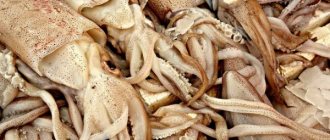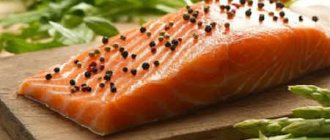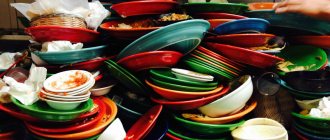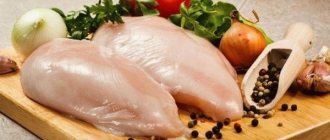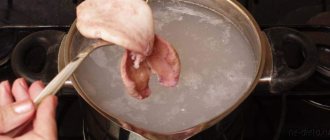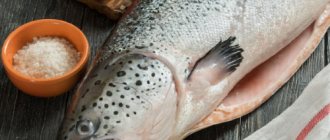How to quickly clean fish from scales
Yes, it takes a lot of time and effort to clean fish from scales, and even more to clean the kitchen after this activity. But I seem to have found a solution to this problem - efficiently, quickly, and the kitchen is in order, I’ll tell you now.
For many years I suffered - I tried everything to scrape it off. Okay, if in the summer: I’ll go out to the garden with basins, fortunately we live in our own house. Everything in the garden is equipped, the water is connected, I drag the table myself and start cleaning - scales fly in all directions, wherever possible.
Honestly, I read about this method, how to easily and quickly clean fish from scales in an apartment, more than 10 years ago in some magazine; I didn’t have the Internet then.
And if this happens in the winter, then you clean so much that you are exhausted in cleaning the kitchen and then washing the towels. It takes a lot of time to clean all my husband's catch.
Glory to the person who came up with this wonderful method... I speeded up the process of cleaning fish from scales, probably 10 times for sure. And now we get to the main thing - the stated topic of the note. Today I am happy to share this recipe with you.
This is the fish I have today, in the photo above. Everything is very simple in fact: you need to take the fish in any way convenient for you (I take it by the eyes) and hold it under a tap with boiling water for 10-20 seconds.
Observe safety precautions: use rubber gloves to avoid being scalded by boiling water.
After this, in one easy movement, without any pressure or tension from the tail, remove the scales from the fish. The scales are removed with great joy, like a feather, without the slightest effort on my part. With one movement, all the scales remained on the knife, as you can see.
What a joy it is not to have to scrape it off the countertops, backsplash and flooring. I use this method for quickly removing scales from fish on any fish: be it river fish or sea fish - it doesn’t matter, in any case my kitchen remains clean. And no cleaning effort is required from me: here are all the scales from one fish, everything is clean all around.
Selected recommendations
Housewives often use a plastic bag, which prevents scales from scattering. They take a fish carcass and place it inside, then scrape off the scales. The waste stays right in the bag. This means you won't have to collect fish particles all over the room. How to clean fish from scales using proven tips:
- To avoid holding the carcass during the cleaning process, it is recommended to nail it directly to the board using an awl or nail. The method is mainly used by tourists on hikes.
- Experts say: in order for the fish to clean itself faster, it is necessary to open its mouth as far as possible and insert a toothpick.
- Stretching the fish until the bones crunch helps simplify the process. First secure it in the ponytail using clips or nails. Now grab the eyes with your fingers and pull the fish towards you. You need to pull until you hear the cracking of bones.
- Sometimes it happens that there is neither a knife nor a spoon at hand, and therefore a problem arises. In this case, an ordinary tin can, a nail and a block will help. Use a nail to make holes in the jar so that the ragged holes are on the outside. Now you need to attach the jar to the block and you will get a kind of homemade grater.
- Nailing beer caps to a wooden plank works great for removing scales. First, prepare a narrow wooden strip and attach the covers to it so that the tip is on the outside. Then scrape to remove the scales.
You can scrape off fish scales in all different ways, using available material.
What are the benefits of river fish?
In fact, it is difficult to overestimate the benefits of perch or chebak freshly caught in the clear waters of the river. This is not store-bought fish, it has lain on the counter for who knows how long, grown on some fish farm and fed with compound feed.
This is a very beneficial product for both adults and children. Such proteins are processed by the body into essential amino acids, which are actively involved in many processes.
Consuming a sufficient amount of protein is necessary for people who perform increased physical work every day - for athletes and those who want not only to lose weight, but also to acquire a toned muscle corset.
Fish has long been used in folk medicine as a remedy. Fish glue stopped hemorrhages, fish oil promoted wound healing, the liver of fatty fish could relieve eyesores, and tench meat was used to treat gout and fever. By the way, in the modern world even medicines are made from fish, such as insulin, pancreatin, compolon.
Vitamin content in fish product:
- Provitamin A is responsible for vision, helps to better navigate in the dark.
- Vitamin D - without it, calcium will not be absorbed, for healthy bones and teeth. It is also useful for the immune system.
- Tocopherol – renews skin cells, synthesizes hormones, for youth and beauty.
- Vitamins B 1,2,3,6,9,12 – benefit the hematopoietic and nervous systems, lower cholesterol and improve immunity, improve memory and mental abilities.
Fish also contains minerals: calcium, iron, magnesium, iodine, phosphorus, zinc, selenium. The easily digestible protein contained in river fish is much healthier than ordinary protein in meat. It’s not for nothing that in Japan people eat mainly fish and live long lives. It also wouldn’t hurt for us to eat 150-200 g of fish - this is the daily norm.
Secrets of quick cleaning
Before properly cleaning fish, you should prepare the work surface and the product itself for processing. The carcass must be thoroughly washed in cold water, removing the mucus. The cleaning process is best done on a cutting board wrapped in plastic or cling film. Such measures will help prevent the fish from sliding, which will make it easier to handle.
To quickly remove the plates, you can use the advice of experienced chefs. These tricks will help you cope with the task in a matter of minutes:
- The fresher the carcass, the easier it is to clean. It is advisable to carry out the procedure immediately after catching.
- Small fish can be rubbed with salt - microparticles will remove most of the scales.
- If the plates do not come off, it is recommended to pour boiling water over the catch. The exposure time should not exceed 10-15 seconds, otherwise the meat will steam.
- It is enough to wash some types of fish thoroughly without removing the protective layer. Thus, perch, salmon, catfish, burbot, bull and bream are cooked without removing the scales. Fish intended for smoking is also not cleaned.
- A frozen carcass is cleaned without preliminary thawing - cold plates come away from the skin more easily.
In order not to stain the surrounding area, you can carry out the cleaning process in a bowl, basin or deep plate with cold water: then the scales will not fly apart and will remain inside the container. A plastic bag is suitable for the same purpose.
You can avoid the troublesome cleansing of scales using the “stocking” technique, which involves removing the plates along with the skin. This procedure is used for preparing multi-component dishes and snacks. Before stuffing or filleting, the carcass must be washed and cleaned of mucus and entrails. Then you should make cuts in the area of the ridge, head and tail, and then carefully remove the skin, separating it from the meat with a knife.
What can you cook from river fish?
An incredible variety of river fish dishes exist in the world, and in Russian cuisine river fish is one of the most important products. Even in ancient times, one of the most important trades for the Slavs was fishing. Therefore, the everyday and holiday table has always been distinguished by a rich variety of fish dishes.
On church holidays such as the Annunciation, the Presentation of the Virgin Mary into the temple and other holidays that occurred during fasting, when the consumption of meat and dairy foods was prohibited, fish dishes occupied a central place on the table.
River catch of “living silver” has always been loved in Rus', but here are just some of the dishes that I learned to cook. And there is still so much to learn, and it’s impossible to list everything...
- Ukha - I know 3 ways to cook it.
- Baked fish in foil in the oven.
- Fried fish is generally a nice thing.
- Stuffed pike is if it is decent in size.
- Fish cutlets - mmm, finger licking good, tender, tender.
- Grilled (we cook it very often in the summer).
- Smoked fish.
Is it necessary to descale chum salmon?
Like most other species of fish, the surface of the body of chum salmon is covered with a kind of shell made of small scales. They are quite rigid and fit tightly to the carcass, protecting it from minor damage, as well as from the effects of harmful microorganisms living in sea water. Before cooking, the scales of chum salmon must be removed.
This procedure must be performed for the following reasons:
- various microscopic parasites that are dangerous to human health can live between the scale plates;
- particles of dirt and dust settle on the shell;
- the scales are hard, so they spoil the taste of the finished fish dish;
- during heat treatment, scales can separate from the pulp, settling on the dishes;
- the dense shell does not allow salt and spices to penetrate the flesh of the fish, making it bland.
Did you know? Any fish grows with age. At the same time, the number of scales on the carcass remains unchanged, but each of them increases in size.
Conclusion
Some husbands clean the catch themselves, while their wives only cook it. With us, this mission rests entirely with me: he will bring the fish, put it in a basin for me, looking as if he had killed a mammoth. The breadwinner! And you, wife, let’s clean it, gut it, and prepare delicious dishes. Fresh food for you, they say, a natural product!
And for as long as we’ve been living with him, since we got married in 1999, I’ve been frowning at the fish my husband caught, because he’s a fisherman. Therefore, both in winter and in summer, and at any moment, as soon as the opportunity arises, he rather runs to go fishing, losing his slippers.
I grumble at him, of course, as without this. It used to bring several kilograms of fish, but what should I do? I always say that all husbands are like husbands - they go fishing to drink vodka. What about him? And he catches it.
My husband is a hereditary fisherman. And his father, it turns out, was a fisherman and his grandfather, and his older brother is also a fisherman.
Dear readers, please use my advice with pleasure: how to clean fish from scales easily and quickly without messing up the kitchen - I hope that it was useful to you. Eat fish and be healthy. Surely you also have some housekeeping tips on how to make life easier at home? Please share your experience in the comments.
What is better to clean fish with a spoon or karcher
To reduce the number of scales flying around the kitchen, you can clean the fish with a spoon. The cleaning process is the same as using a knife or grater, but the advantage is that most of the scales remain inside the concave part of the spoon.
We recommend reading:
Hiking and tours to Kamchatka
At the same time, it is cleaned quite simply and relatively quickly. For greater convenience in this case, it is better to place the fish on the table and hold it with your hand. By the way, even if it is slippery and heavily covered with mucus, this will hardly interfere with its cleaning using this method, perhaps only slowing down the process a little.
Another unusual method invented by motorists is the use of a Karcher portable car wash. The fact is that water from the hose is supplied under high pressure. If you press the fish to a hard surface, for example, to the ground, and direct a jet at it, the scales themselves will fly out from under its pressure.
But rest assured that you will be guaranteed a fountain of scales mixed with splashes. It may not be possible to completely clean the fish in this way, but most of it can definitely be freed from the outer cover, and the remaining scales can be removed manually. What is better to use in this case? Hard to tell. Everyone chooses a method at their own discretion.
Some people want less dirt, while others want less fiddling with their hands. The final choice of cleaning tool will depend on this.
Author of the publication
offline 3 years
Nika
10
I am interested in hiking and traveling, photography and videography. I have been going hiking since childhood. The whole family went and went - sometimes to the sea, then to the river, to the lake, to the forest. There was a time when we spent a whole month in the forest. We lived in tents and cooked over fires. This is probably why I am still drawn to the forest and, in general, to nature. I travel regularly. About three trips a year for 10-15 days and many 2 and 3 day hikes.
Comments: 0Publications: 668Registration: 10/23/2018
Nika Survival in the wild, Nutrition in the wild, Articles
What do you need to clean fish?
Fish cleaning tools
- Sharp knife
. If this is your first time doing this, do it with the blunt side and or use a dull knife. After all, large scales can be removed even with a fork. If you have a scraper adapted for this purpose or a grater, then in the case of small scales this will be great.
TIP: Make your own grater. Previously, bottle caps helped out - I nailed a few to a board and off I went. Now you can take an empty tin can, cut its ends, and nail it to a board with the bottom.
- Paper towel.
- Cutting board.
- Kitchen scissors.
- Water for rinsing hands.
Text of the book “Cooking Fish”
2.2. Fish cleaning
Cleaning fish is generally an unpleasant task: the scales come off poorly, stick to your fingers, bounce off in all directions... As mentioned above, you can dip the fish in boiling water for a few seconds - this way the scales are easier to clean off.
If the fish is slippery, dip your fingers in the salt and it will go faster. Fish can be cleaned well if you lightly rub it with vinegar and leave for 10–15 minutes. The scales should be removed from the tail, but not along the body, but slightly obliquely, without squeezing the body of the fish too much, so as not to crush the gall bladder. Arc method - scales are scraped off by placing the fish in water
so that the scales do not fly apart. The scales are cut off from frozen fish.
Fish with small, tight-fitting scales (some breeds of marine fish, for example, horse mackerel) are cleaned either with a special scraper or with a grater under a gentle stream of cold water.
It is also convenient to use special fish scalers when processing. In this case, it is recommended to immerse the fish in boiling water for a few seconds before cleaning.
Clean the fish by holding the tail, against the scales, in the direction from the tail to the head.
. You need to start cleaning from the back.
The fish is much easier to clean if you first cut off all the fins with scissors. Fins
It is best to cut with scissors, and to remove the hard dorsal fin, shallow cuts are made along the entire length with a sharp knife. Grabbing the fin with a towel (so as not to prick yourself), pull out the fin in the direction from the tail to the head.
If you are going to cook the fish whole, then you can leave the scales on during cooking.
. In this case, the fish is opened, the entrails and gills are removed, washed with running water and boiled. It is very easy to remove the skin and scales from boiled fish.
If salted fish
with scales, the scales, head, fins, and caudal fin are removed.
Frozen fish must be cleaned immediately after thawing. First of all, sharp fins are cut off from ungutted fish and scales are removed. To make the scales easier to remove, the fish should not be dry. Cleaning should begin from the tail. To do this, you can use various types of scrapers or the blunt end of a kitchen knife.
Gutting fish
The fish, freed from scales and fins, is gutted. You can gut the fish through the cut belly, through a cut at the head or through the back: it all depends on the further use of the fish.
Through a cut at the head
or the fish is gutted through the gills if it is being prepared for stuffing or if they want to cook it uncut. In this case, the belly of the fish remains intact.
If you are going to cook the whole fish, either stuff it or make a jellied fish from a whole fish, then it is preferable to gut it through the gills to preserve the shape of the fish. With your fingers, pull out all the insides in one piece through the gill slit, along with the gills. Rinse the fish in cold water.
To clean a flatfish whose innards occupy a small area just below the gills, simply make a small cut behind the gills and pull out the innards.
Sometimes, to remove the entrails of large fish, two incisions are made - at the head, and the entrails are removed through the incisions. Very large fish often have their heads cut off.
Through the cut-out back
the fish is gutted when it is prepared for roll or stuffing. For this, fish with large dorsal fins are usually used. When gutting such fish, cuts are made on both sides of the dorsal fin, then the fins are removed and the entrails are removed through the same hole.
Small and medium-sized fish are often gutted without opening the abdomen
. To do this, the head and part of the entrails are separated, and the abdominal cavity is cleaned through the resulting hole. After this, the carcass is thoroughly washed.
After removing the insides, the film covering the bottom of the vertebral bone is cut off, the kidneys and the dark film lining the abdominal cavity are cleaned. If the film is light, it is usually not removed; only black and dark gray films are removed.
Fish weighing up to 200 g is used for thermal cooking with the head. After cleaning the fish from scales, the abdomen is cut from the head to the anus and the entrails are removed along with the gills.
For fish weighing from 200 g to 1 kg, the head is cut off. For gutting, a deep cut is made in the flesh at the edge of the gill covers, the vertebral bone is cut and the head is separated, and most of the entrails are pulled out along with it. Their remains are removed without cutting the abdomen.
Another way: cut off the head just behind the gill openings. Using large scissors or a sharp knife, cut through the abdomen to the anus, remove the entrails, and run the knife along both sides of the ridge to remove any accumulations of blood. After this, rinse the fish in cold water.
Evisceration through the abdomen
- a quick and convenient method, especially if you later want to separate the meat from the bones or cook fillet.
In fish weighing more than 1 kg, after cleaning from scales, the abdomen is cut from the head to the anus, the head is separated along with the entrails, and the fins are cut out. For smaller fish: without separating the head, cut the fish along the belly
, remove the liver, and then all the other insides. After gutting, rinse the fish thoroughly in cold water.
When cutting the abdomen
You must try not to damage the gallbladder, otherwise all the fish will be bitter. If bile does spill, wipe the affected areas with salt and rinse with cold water.
If the insides of the fish are in a black film
, the film must be removed, and then rinse the fish in cold water.
Blood clots and film
, which are located in the abdominal cavity of all fish along the spine, should be removed when gutting the fish, as they give an unpleasant aftertaste and contribute to spoilage of the fish. They are removed by scraping with a knife, wiping with salt, a brush, clean gauze or a cloth.
The gills must be removed
, since after heat treatment they can give the fish bitterness. For the same reason, most cooks also remove the eyes from the fish.
Elena Molokhovets notes that if the fish is intended for a pie
, after gutting it must be washed, wiped, rubbed with salt on all sides, taking a teaspoon of salt for each pound of fish, and then wrap it tightly in a napkin, let it lie for 2 hours to dry it, otherwise from excess moisture “it will be in the dough it will become hardened.”
2.3. Fish cutting
Depending on what is planned to be prepared from the fish, it is processed differently. For example, in fish that will be used to make fish soup
, they throw out only the insides (the fish bladder is left - it improves the taste of the fish soup) and the gills, which add bitterness to the finished dish, and the head and scales are left - they make the broth richer, tastier.
From fish intended for frying,
the scales, entrails, gills, and head are removed.
Fish is also cut differently depending on the breed and what dishes need to be prepared from it.
Before you start cleaning a live fish, you need to slaughter it: with the sharp end of a small knife, make a deep cut in the throat between the head fins and allow the blood to drain.
Cutting fins
from fish is far from the most pleasant experience. To make it easier, we offer the most convenient following method. The best tool for cutting fins is scissors. To remove the dorsal fin, which is the hardest, you must first make cuts in the skin around it, and then grab the edge of the fin with a piece of fabric and try to tear it out of the carcass.
Another way to remove fins:
Place the fish on a cutting board and use scissors to cut off the dorsal fin, making a cutting motion towards the tail. If you are going to remove bones, then cut off the entire dorsal fin. Then insert the tip of the knife into the bone tissue underneath the fin that connects the fin to the fish's body, and remove the fin and bones, using the knife as a lever. Finally, cut off the pectoral, ventral and anal fins.
For fish weighing from 200 g to 1 kg, the head is cut off, and the carcass is used whole or cut into pieces, but more often it is prepared unlined.
Gutted and washed fish weighing more than 1 kg are plastered
, that is, cut along the back along the spine into two parts.
If you cut off the rib bones from one half, and the rib bones and spine from the other, you will be left with a fillet
.
Large fish weighing 1–1.5 kg are cut into round pieces across the carcass.
If you need to fillet
fish that weighs more than 1 kg must first be cleaned of scales, then the fins and head must be cut off. After this, pressing the fish firmly to the board or table, use a sharp knife to divide the fish in the direction from head to tail. The knife should be held at a slight angle to the plane of the board. In addition, the knife must constantly touch the vertebral bone of the fish. The resulting two fish plates are the fillets. Now all that remains is to remove the rib bones remaining in the pulp, trying to leave as little meat as possible on them. If the skin is rough, it is also carefully cut off.
Fish skin
and the surface of the peritoneum form a protective membrane.
Particular care should be taken not to pierce or cut the intestines
so that its contents do not fall into the abdominal cavity. The blood and mucus covering the fish with adhering dirt are washed off. At the next stage of preparation, washing the carcass must be repeated.
When cutting fish, you should try not to damage the flesh.
.
It is not recommended to bend or crush the fish too much, as this deteriorates its quality. Bacteria easily penetrate into fish meat through damaged areas. Frozen fillets and frozen sturgeon should not be subjected to strong mechanical stress, as
impacts or strong squeezing will cause juice to leak out and the taste of the dish will deteriorate. Therefore, they should be cut without waiting for complete defrosting, as soon as the pulp can be cut.
Rinse processed and cut fish carcasses and fillets thoroughly. Thawed fish
It is necessary to rinse thoroughly
before cutting
until mucus, blood, and films are completely removed.
To wash fish you need clean water.
, better flow-through. Since some of the nutrients dissolve in water and the fish becomes less tasty, it should not be kept in water for a long time. But, on the other hand, it is advisable to wash the fish more thoroughly and for longer, thereby reducing the risk of spoilage.
When cutting fillets, you must hold the knife at a slight angle*), constantly lightly resting it on the vertebral bone. From the removed fillet, cut off the rib bones and skin (if it is rough) with a knife.
From the bones and heads of sea fish, which remain after being filleted (fins , gills and eyes are separated from them, giving a bitter taste
), it is recommended to cook fish broth, which can be used to prepare fish sauces and soups.
If you cook the whole fish, you need to sprinkle vinegar or lemon juice on the skin and abdominal cavity.
You need to salt the fish immediately before cooking and very carefully to avoid juice from escaping from the fillet. If the fish remains salted for a long time, the meat will become dry.
If you do not immediately start cooking fish, after gutting and washing it should not be cut into small pieces or fillets
, but it’s better to leave it whole. The smaller the cuts, the more exposed meat that is easily susceptible to bacterial contamination and spoilage.
The table below summarizes specific techniques for cleaning and cutting fish.
Features of cutting specific types of fish
2.4. Getting rid of odor
Specific smell of cod or other sea fish
will disappear if you hold it in a vinegar solution (2 tablespoons per 1 liter of water) or rub it with a cut lemon. For flounder, in addition, you need to remove the skin from the dark side of the carcass. If the fish is intended to be boiled, you can pour fresh milk into the pan instead.
To get rid of the unpleasant smell of fish, gutted fish can be soaked in a solution of vinegar with 3 bay leaves or chopped onions for 3 hours. You can also rub the fish with lemon.
So that the fish does not smell like mud
, it is washed in a very strong cold salt solution (some experts advise adding soda as well) or rubbed with black pepper and dill, and after 20 minutes it is washed and cooked using dill.
Fresh fish (especially pike) will not taste like a swamp if you put two or three hot birch coals into the water with the fish.
You can also get rid of the smell of mud this way: clean the fish, wash it, cut it into pieces, put it in an enamel bowl, sprinkle with finely chopped bay leaves, pour in lukewarm water and leave for 1 hour under the lid. Before cooking or frying, drain the water and do not rinse the fish.
There are several ways to get rid of unpleasant odor in sea fish.
. 1. Take a sea fish and clean it of scales. Moisten a cloth napkin or just a piece of cloth with vinegar and wrap the fish in it. The fish should remain in this state for 2–3 hours. Moreover, you need to defrost it not quickly, but gradually. 2. You need to cook this fish in a saucepan with a bay leaf and allspice peas. Additionally, you can wrap a cloth soaked in vinegar around the inside of the pan lid.
The old way
getting rid of the muddy smell, described by Elena Molokhovets: “To correct the taste of carp caught in a pond, before slaughtering it, you need to let it absorb strong vinegar.”
To be destroyed by cooking
for the specific smell
of cod, flounder, pike, catfish
, add, in addition to roots, onions and spices, 0.5 cups of cucumber brine for each liter of water.
Some fish breeds have a strong, specific odor. To get rid of this smell when cooking or stewing fish
, add a little
milk
, as is customary among the peoples of the North. The smell will disappear, and the fish will become more tender and more pleasant to the taste.
Below are odor removal methods that apply to specific fish species.
Pike
To prevent it from smelling like a swamp, it should be washed in cold, well-salted water. If the fish smells like mud, it is also dipped in a strong cold solution of salt and then the unpleasant smell disappears. If boiled pike is being prepared, then the amount of spices should be significantly increased, since this fish often has an unpleasant aftertaste.
Crucian carp and tench
they smell like mud. To remove this smell, you need to immerse them in a cold salt solution for half an hour. Then rinse the fish in running water.
Tench pulp
very tasty and tender, but with a slight aftertaste of silt. To get rid of it, fish is boiled with various spices. In the old days, to improve the taste, live tench were kept in running water for 12–14 hours.
Knife used to peel herring
, you need to rub it with carrots or potatoes and the smell will disappear.
The unpleasant smell of mud will disappear if the fish is washed in a cold salt solution.
Another problem is removing fish odor from dishes
.
The unpleasant smell of fish from your hands and dishes
can be removed by washing them with water and vinegar (a spoonful of vinegar per 2 liters of water). If the dishes retain the smell of fish, they should be washed with a solution of warm water and vinegar (1 tablespoon of vinegar per 2 liters of water).
You can remove the smell of fish from a wooden cutting board by rubbing it with a piece of lemon before cutting the fish!
Wood, as an absorbent, absorbs the primary odor. After cutting the fish, all that remains is to wash the board.
The unpleasant smell on the knives you used to chop onions or fillet fish will disappear if you rub the blades with heated salt, lemon peel or tea leaves.
Forks and knives will also not smell fishy if you rub them with fresh lemon peel or grease them with vegetable or butter.
Fish dishes must first be wiped with a paper napkin, rinsed with cold water, and then washed with warm water and soap, vinegar or dry mustard.
Fishy smell in the refrigerator
or a saucepan can be eliminated with household chemicals that absorb odorous substances from the air. They are placed in closed containers - a refrigerator or a pan - for several days.
Fish snacks
3.1. Dried fish
3.1.1.
Selection of fish According to experienced fishermen, you can “make ram” (that is, simply dry it) not only from ram roach,
but also from any other fish.
Experts say that the best taste in dried form is distinguished by roach, ram, roach, silver bream, bream, sabrefish, bleak, ide, perch, pike, carp, capelin, mackerel.
Others advise drying
rudd, pike, pike perch, and bream
.
Optimists claim that all types of fish are suitable for drying, except burbot and catfish
.
It is believed that the fatter the fish, the more it acquires new valuable qualities from drying. 3.1.2.
Time for harvesting Experts believe that it is better to dry fish in the spring
, in cool and dry weather.
It is not recommended to do this in the summer because fish oil quickly becomes rancid. 3.1.3.
Preparing fish There is an opinion that freshly caught fish should not be immediately processed for drying. First, the fish is kept for 2–3 hours in a cool place in a pile, mixed with grass (preferably nettle), then prepared for salting.
Fish weighing up to half a kilogram can be salted without gutting.
At the same time, the subcutaneous fat and fat from the insides of the fish soak into the meat during drying, and the fish becomes much tastier.
At the same time, it is not recommended to cook dried fish without gutting in the summer
, since most herbivorous fish during this period feed on greens, which quickly decompose in the abdominal cavity and give the meat a bitter taste and unpleasant odor.
In addition, many herbivorous fish are affected by parasites. For larger fish, the entrails are removed. If caviar is found, it is put back into the belly. 3.1.4.
Salting fish for drying 3.1.4.1. Salting
For salting, it is best to use coarse salt. Fine salt can “burn” the fish - form a crust through which the brine will not be able to penetrate into the meat. They say that fish acquires a more delicate taste if granulated sugar
(for 1 kg of salt, a tablespoon of sugar).
3.1.4.2.
Utensils for salting fish using the wet method
Enameled dishes, tubs, thick boxes, stainless steel containers are suitable.
Galvanized basins and buckets, plastic containers for technical needs are not suitable.
When fishing, you can also salt fish in plastic bags, burying them in the ground. The neck is left open with oppression placed on top.
With dry salting
use
baskets, wooden boxes or containers with a hole in the bottom, on the bottom of which
a clean canvas rag or burlap is laid. In this case, the resulting liquid flows out through the cracks. They say that in field conditions, fish sprinkled with salt are stuffed into cotton bags, which are buried in the ground (about a meter).
Often a weight is placed on the fish - a circle knocked from boards or sawn from a single piece of wood. Experts recommend using linden or aspen
(a circle made from wood of these species does not emit resin or tannins and does not deform in brine).
Experts say that it is necessary because it prevents the formation of air cavities in which putrefactive bacteria can develop, and, in addition, makes the fish flesh more dense. 3.1.4.3.
Soaking According to some experts, the fish should be soaked for as long as it was in the brine
. Soak the fish in running water or fresh cool water, which is changed frequently.
On the Stalker website you will find more than 50 drying recipes for 12 types of fish.
3.1.5.
Drying 3.1.5.1. Hanging method
The biggest difference in fish drying technology is how to hang the fish: by the tail or by the head. There are experts who believe that it is better to head down. In this position, moisture flows out through the mouth
, and the fish dries faster and more evenly.
Another explanation is that in this case the contents of the stomach will flow out through the oral cavity and the meat will not be soaked in it. Others believe that hanging by the tail is “the last resort,” since with this technology fat is removed
.
In this case, the fish is hung through the eye holes
, the internal fat in this case is absorbed into the meat and a slight gall bitterness gives the finished product a unique taste, which especially appeals to beer lovers.
It is best to dry fish on stainless wire hooks. Most often, fish are strung through the eye sockets onto a wire or cord. To prevent the carcasses from moving along the cord and touching each other, the cord is threaded through the eye sockets twice. Experienced fishermen use this method to string the fish onto pieces of cord in a garland (5 pieces each) and hang it on a stretched wire. In the wind, fish garlands sway and fish carcasses spin around the cords. Thus, as the fishermen explain, the fish drys out faster.
For the same purpose, spacer sticks are usually inserted into the abdomen. Before hanging, the gill covers are opened and slightly folded.
. In this case, the gills dry out quickly.
